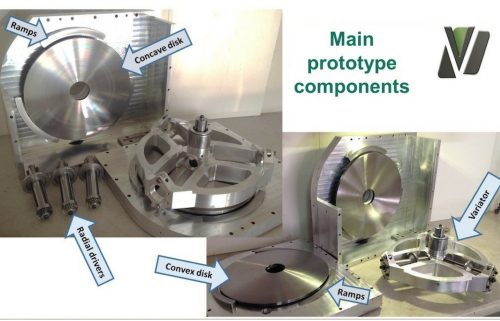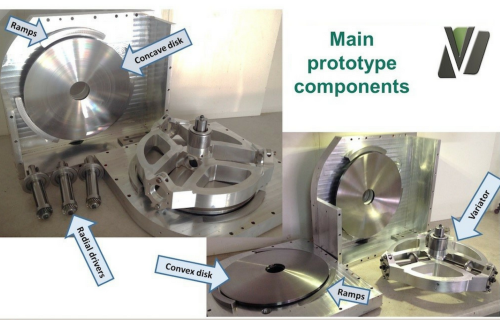
INTRODUCTION
Currently all commercial continuously variable transmissions (CVT’s) in the automotive industry function on a traction drive principle. This traction drive interface exists between two hardened smooth steel surfaces separated by a traction fluid film. Traction fluid has the unique property in that it solidifies under high pressure, typically between 1 to 4 GPa, and then provides a traction coefficient of traction that varies from about 0.05 to 0.1. A number of factors determine the traction coefficient as well as the efficiency of the traction drive and as a result current commercial CVT’s do not feature high mechanical efficiencies, with a typical average mechanical efficiency of about 85%. Traction drive technology is a very well matured technology and has been in development since the 1980’s.
Automotive Transmissions and the RADIALcvt
Following the development, patenting and successful prototype tests on our ground-breaking continuously variable transmission, the RADIALcvt, Varibox CVT Technologies has been receiving a flood of queries related to how the innovation fares against current automobile transmissions. The product pitch document below explains some of the key individual features of the RADIALcvt as proof that it as an ideal solution for solving the low mechanical efficiency and complexity issues associated with current CVT’s should you be interested in understanding the technology for licensing of the product. This document is written in non-technical terms.
Read the Automotive Transmission Explained and Compared to the RADIALcvt here.
Also, for your understanding, we have taken time to outline the technical characteristics of various types of automobile transmissions currently available on the market and compare the RADIALcvt to these. You are welcome to read about these in the following document.
Automotive Transmission Explained.
RADIALcvt EXPLAINED
The RADIALcvt is a multi-parallel power path type of continuously variable transmission (CVT), that consists of only one steel-on-steel traction drive interface in each path.
RADIALcvt features a single traction drive interface in series and at least 6 power split traction drive parallel paths. A constant input radius on the traction drive input make it possible to use a constant clamping force which is provided by springs. Therefore RADIALcvt concept has no hydraulic control system.
The RADIALcvt has a very large radius variation on the traction drive output which provides the ratio variation. Due to the fact that the Radial drivers are clamped between two opposite rotating disks, results in the largely cancelling out of the forces on the Radial drivers. The RADIALcvt’s first ratio is hard geared to eliminate the “kerb test” issue common with push belt CVT’s.
Watch this video to learn more about RADIALcvt.
SIM ULATION
With Patents granted and a solid concept and design, VARIBOX CVT Technologies were keen to show, on more than just paper, the benefits of the RADIALcvt. And after completing a comprehensive simulation, the benefits are obvious. The simulation was completed in May 2017 and shows very promising results, demonstrating the innovation's enormous fundamental advantages over current commercial and known developmental CVT's.
You can read more about this by clicking through to this news article
Additionally if you would like to read the detailed white paper on the RADIALcvt simulation, click through to this white paper
RADIALcvt as an EV transmission
The pure electric vehicle is here to stay and will increase its stepped ratios to 3 and 4 and its market share will grow and development will continue as reported by ZF (Tom, 2014) and Bosch (Beissmann, 2014). The primary power source in electric vehicles, the electric motor, however share some disadvantages with the internal combustion engine. This includes the fact that the electric motor and its drive/inverter are not equally efficient under different loads and speeds. With a typical electric vehicle, electric motor efficiency varies between about 92.5% and about 70% as reported by Antonov plc (David, 2011)
The RADIALcvt is an ideal electric vehicle CVT transmission within a power range of 30kW to 130kW with a maximum ratio range of 2.3. Simulation has shown that the variator contact efficiency will vary from about 95.8% to 98.7%. The RADIALcvt does not make use of a hydraulic control system and does not need a clutch. The RADIALcvt mechanical efficiency is at most within an estimate of about 3% less than the stepped transmissions while it is much more compact lengthwise than the stepped transmission with a clutch or dual clutch.
The RADIALcvt thus provides an excellent solution to pure electric vehicles, because of its simplicity and fundamental advantages with very high mechanical efficiency.
Click through to this detailed white paper for more information
RADIALcvt PROTOTYPE


A fully functioning RADIALcvt prototype has been built. The prototype was designed to take a maximum input torque of 100N.m and a maximum power of 46kW at 4400 rpm. Both the concave and convex disk diameters are 292mm and the work parts end to end have a length of 262mm. Numerous tests are currently underway, which will culminate in a full set of tests by one of the leading South African mechanical engineering university faculties. All these results will be published on the website as soon as they are available. To date, the internal tests are all looking extremely positive.
Click here to download the latest Prototype Design document. No load, 100% clamping force spinning tests and loaded efficiency tests are discussed in section 8 of the document.
DOWN LOADS
For further videos, presentations and documents detailing the components, mechanisms and application of the RADIALcvt, please click here
QUICK FACTS
- The input power is divided into six parallel power paths with each path encountering only ONE traction drive interface in series (all existing commercial CVT's have at least two traction interfaces in series which produce a compounded traction loss).
- The stress in the metal-on-metal contact in the traction drive can be kept below 2GPa because of above parallel power paths and thus avoid expensive materials.
- A constant input radius on the traction drive input results in constant clamping force.
- A constant clamping force is generated via springs. No hydraulic control system is required.
- A very large radius variation on the traction drive output provides the ratio range.
- Ratio actuation is electric via 12V DC motor, controlled by PWM (pulse width modulation).
- A hard-geared (direct drive which bypasses the variable traction drive ) first ratio is included to overcome the "kerb test" issue common with push-belt CVT’s.
- A concept design for a 40kW front wheel drive vehicle (for example a three-cylinder Chevrolet Spark) is available to demonstrate compactness and suitability.
- Can serve in a hybrid vehicle and serve as an energy recovery device.
- RADIALcvt is scalable.
